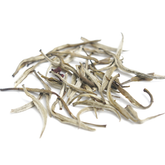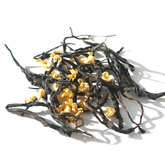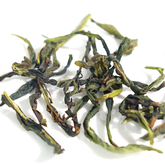Complete Guide to Tie Guan Yin Tea: Origins, Varieties, Brewing, and Health Benefits
On international e-commerce platforms like Amazon, 63% of "Tie Guan Yin Tea" products are mistakenly categorized as "Green Tea." Tie Guan Yin, one of China's top ten famous teas, comes from Anxi County in Fujian Province, and is renowned for its captivating aroma and flavor. Tie Guan Yin is both the name of the tea and the tea plant variety. However, it is important to note that Tie Guan Yin is actually classified as an oolong tea , not green tea.
This article will comprehensively explore the origins, flavor profile, classification, brewing methods, and health benefits of Tie Guan Yin tea, helping readers gain a full understanding of this unique and cherished tea.
Recommended purchase:
Oolong Tea — Anxi Tie Guan Yin (Light Type)

Where Does Tie Guan Yin Tea Come From?
Tie Guan Yin's primary production area is Anxi County in Fujian Province, China, which is known as the "Home of Oolong Tea." Tea cultivation and production of Tie Guan Yin began here as early as the 18th century, giving it over a thousand years of tea-growing history.
Anxi County has a unique geographical environment, including a warm, humid climate and fertile soil, which provide ideal conditions for the growth of Tie Guan Yin tea plants, resulting in tea of exceptional quality.
What makes tie kwan yin tea so unique is that it is both the name of the tea and the tea plant variety. Today, Anxi's tea gardens cover over 600,000 acres, and Tie Guan Yin production accounts for more than one-third of China's total oolong tea production. It is also the largest oolong tea-producing region in the world. Tie Guan Yin tea has won numerous international awards and is one of the most well-known oolong teas globally.
Types of Tie Kwan Yin Tea
Oolong tea is divided into two main categories based on the fermentation level: light fermentation (fragrant type) and heavy fermentation (strong fragrance type). It’s important to note that the taste of heavily fermented oolong tea (strong fragrance) is quite different from lightly fermented oolong tea (fragrant type).
For example, popular oolong teas like Phoenix Dan Cong and Oriental Beauty fall under the strong fragrance category, characterized by roasted flavors, deeper tea color, and a rich, bold taste. Heavily fermented oolong teas are more suitable for those who prefer strong aromas and robust flavors, but they may not be ideal for beginner.
 When buying oolong tea, you can pay attention to product labels. Compliant products will clearly indicate whether the oolong tea is of the fragrant or strong fragrance type. Labels marked "Light Roast" typically refer to the fragrant type, while "Traditional Roast" refers to the heavily roasted strong fragrance type.
When buying oolong tea, you can pay attention to product labels. Compliant products will clearly indicate whether the oolong tea is of the fragrant or strong fragrance type. Labels marked "Light Roast" typically refer to the fragrant type, while "Traditional Roast" refers to the heavily roasted strong fragrance type.
How to Store Tie Kwan Yin Tea
Tie Kwan Yin is a lightly fermented oolong tea, and like green tea, it is very susceptible to oxidation, so proper storage is crucial. In simple terms, the four key points for storing Tie Guan Yin tea are sealing, moisture control, light protection, and low temperature.
 The correct method is: First, store the tea in an airtight container to prevent oxygen in the air from accelerating the deterioration of the tea. Second, ensure the tea is kept dry to avoid moisture that could cause mold. Third, protect the tea from light, as exposure to light can damage its aroma and color. Lastly, store it in a cool place—ideally in a sealed bag or container in the refrigerator’s chilled compartment . This can effectively preserve the freshness and aroma of Tie Guan Yin tea.(Expand Reading: Does Tea Expire? How to Properly Store Your Tea )
The correct method is: First, store the tea in an airtight container to prevent oxygen in the air from accelerating the deterioration of the tea. Second, ensure the tea is kept dry to avoid moisture that could cause mold. Third, protect the tea from light, as exposure to light can damage its aroma and color. Lastly, store it in a cool place—ideally in a sealed bag or container in the refrigerator’s chilled compartment . This can effectively preserve the freshness and aroma of Tie Guan Yin tea.(Expand Reading: Does Tea Expire? How to Properly Store Your Tea )
Tie Kwan Yin Tea Brewing Guide
For fragrant tie kuan yin tea, it’s recommended to use a Gaiwan (a traditional Chinese tea brewing vessel) to allow proper airflow. Glass cups should be avoided as they can cause the tea to become bitter. It’s highly recommended to brew with the traditional Chinese Gongfu tea method for the best experience.(Expand Reading: A Beginner's Guide to Traditional Chinese KungFu Cha ) Use boiling water (100°C) to quickly release the orchid aroma of the Tie Guan Yin tea. The ideal tea-to-water ratio is 5g of tea to 150ml of water (1:30). Steep the tea for 15 seconds in the first infusion, and increase the steeping time by 5 seconds for each subsequent infusion (second steep for 20 seconds, third for 25 seconds, etc.). High-quality Tie Guan Yin tea can be brewed for 6-8 infusions.
Use boiling water (100°C) to quickly release the orchid aroma of the Tie Guan Yin tea. The ideal tea-to-water ratio is 5g of tea to 150ml of water (1:30). Steep the tea for 15 seconds in the first infusion, and increase the steeping time by 5 seconds for each subsequent infusion (second steep for 20 seconds, third for 25 seconds, etc.). High-quality Tie Guan Yin tea can be brewed for 6-8 infusions.
TieGuanYin Tea Brewing Guide
| Item | Recommendation | Notes |
|---|---|---|
| Tea Ware | GongFu Gaiwan | Better airflow; glass cups can trap heat and cause bitterness |
| Tea-to-Water Ratio | 5 g tea to 150 ml water (1:30) | Adjustable—add more leaves for a stronger brew |
| Water Temperature | 100°C (boiling) | Boiling water unlocks Oolong's full, rich aroma |
| Steeping Rhythm | 1st steep 15 s; add 5 s each subsequent steep; 6-8 steeps total | Extend steep time if you prefer a bolder flavor |
Health Benefits of Tie Guan Yin Tea
The health benefits of Oolong tea have been confirmed through various studies. According to research published in the American Journal of Clinical Nutrition, drinking 300ml of Oolong tea daily can increase metabolism by 12%, promoting fat breakdown after meals, making Tie Guan Yin tea an excellent choice to drink after eating.
The Harvard T.H. Chan School of Public Health has found that regular consumption of Oolong tea can reduce the risk of cardiovascular diseases by 19%. This is attributed to the antioxidant properties of tea polyphenols (EGCG), with the antioxidant content in each cup of Oolong tea equivalent to three strawberries. Its moderate caffeine content (about one-third of coffee) provides a gentle energy boost without causing heart palpitations, making it a great option for those sensitive to caffeine.
In summary, Tie Guan Yin tea is a natural beverage with no added flavors. Drinking Oolong tea in moderation every day not only offers a refreshing taste but also provides both energizing and health-promoting benefits.
Summary of Fuding Tie Kuan Yin Tea
Tie Guan Yin is often mistakenly classified as green tea, but it is actually an Oolong tea that originates from Anxi County, Fujian Province, China. Most Tie Guan Yin teas are lightly fermented, so when purchasing, be sure to look for labels such as "Light Roast" or "Traditional Roast." Tie Guan Yin should be stored similarly to green tea—sealed, moisture-free, away from light, and kept at a low temperature.
Tie Guan Yin tea offers many health benefits. Drinking it in moderation not only provides a refreshing taste, but its rich tea polyphenols and moderate caffeine content can help boost metabolism, provide antioxidants, and support cardiovascular health.
FAQs about Tie Guan Yin
Q1: What is Tie Guan Yin tea?
Tie Guan Yin is a famous Chinese oolong tea from Anxi, Fujian. It’s known for its floral fragrance and smooth, refreshing taste.
Q2: Is Tie Guan Yin a green tea?
No, it’s not green tea. Tie Guan Yin is a partially oxidized oolong tea, sitting between green and black teas.
Q3: How do you brew Tie Guan Yin tea?
Use water around 90–95°C (194–203°F), steep 1–2 teaspoons for 30–60 seconds. Multiple infusions are ideal for the best flavor.
Q4: What does Tie Guan Yin tea taste like?
It has a floral, orchid-like aroma with a smooth, sweet, and slightly creamy finish.
Q5: What is Tie Guan Yin tea good for?
It may help with digestion, offer gentle energy from caffeine, and provide antioxidants that support overall wellness.
SEE MORE ABOUT TEA
If you are a beginner about Chinese tea:
Basic-Guide-to-Chinese-Tea
If you have questions about selecting tea:
Learn-more-about-chinese-tea
If you have questions about the benefits of tea:
Health-benefits-of-chinese-tea
If you have questions about brewing tea:
How-to-brew-loose-leaf-tea






